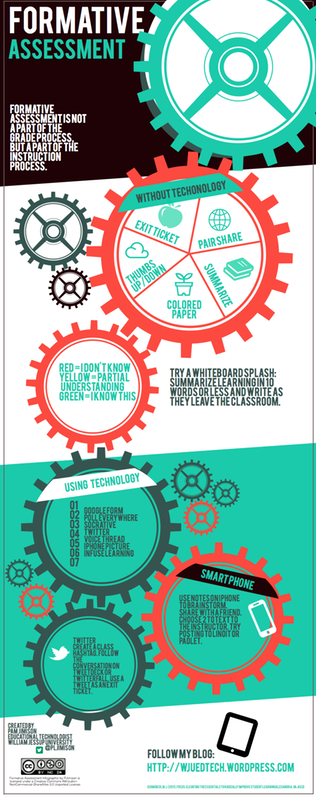Check for Understanding
Formative assessment = Assessment FOR Learning
Formative assessment encompasses all those activities undertaken by teachers, and/or by their students, which provide information to be used as feedback to modify the teaching and learning activities in which they are engaged. Such assessment becomes formative assessment when the evidence is actually used to adapt the teaching to meet student needs. – Black and Wiliam

High-quality formative assessment practice can take many forms, but it must always does the following:
- emphasizes the quality rather than the quantity of student work;
- values giving advice and guidance over giving grades;
- avoids comparing students in favor of individual students assessing their own learning;
- fosters dialogue that explores understandings vs. lectures that present information;
- encourages multiple iterations of an assessment cycle, each focused on a few issues;
- provides feedback that engenders motivation and leads to improvement.
National Council of Teachers of English (2010)
Universal Design for Learning and Formative Assessment
Designing UDL Formative Assessments
Just as students learn differently, they also demonstrate their progress toward learning differently. Formative assessments should be developed using the principles of universal design for learning to minimize the effect of the assessments’ physical, sensory, learning, cognitive, or language barriers that may interfere with the accuracy of the assessment. The UDL guidelines state that “in reality, there is no one means of expression that will be optimal for all students; providing options for expression is therefore essential” (CAST, 2010).
This means educators need to offer students multiple, equally valid, assessment options to demonstrate their understanding of a learning target. For example, if a teacher is assessing progress toward creating a persuasive argument in a social studies classroom, instead of requiring a quick write, he or she could offer students a choice of composition tools such as written text, recorded speech, images and audio or video to complete the assessment. Providing student the opportunity to choose the method that works best for them, removes the barriers often inherent in requiring just one method (e.g. quick write only, may result in barriers to expressing understanding due to poor spelling, typing, writing etc).
Analyzing the Data and Responding to Formative Assessments through a UDL Lens
Formative assessments are a great way to identify student misconceptions and the learning barriers that students are experiencing. When teachers analyze the data, they should look for student strengths and gaps in understanding. It’s important to note, that the cause of the gaps may be different for each learner. For example, if students are struggling with adding fractions, one student may be having difficulty with place value, while another one student might be having difficulty with the steps of the operations, while another still could be having difficulty with the abstract concept of what a fraction represents. Understanding what got in the way of learning the material is essential to identifying which instructional activities will be the most beneficial for each student. In our example, some students will benefit from math manipulatives such as fraction bars, while another student would benefit from watching an expert solve the problem, while still another would benefit from solving guided practice problems with immediate feedback. With this in mind, teachers can offer a variety of options so that all of their learners are successful.
Formative Assessment Tools
Voice Recording Tools for Formative Assessments (exit slips, blog responses)
Record voice here and add URL to blog, email, text, Blackboard to turn in audio responses.
Use an iPod Touch, iPhone or iPad to record a message and email recording.
QuickVoice App for the iPad
Online Polling
Create a simple feedback poll or leave the questions open ended. Capture the feedback from the students almost instantly.
Socrative: Students responde via website or app.
Poll Everywhere: Students respond via text message, a website or even Twitter.
Google Forms: Collect student responses using and get real-time graphs of answers.
Discourse and Dialogue
Try these virtual cork boards for students to leave sticky note questions, comments, reflections on their learning. They are easy to set up (no account needed), available anytime, anywhere and free.
Providing Feedback:
Kaizena: Provide audio feedback in Google Documents. Check out this blog post for more information!
Additional Formative Assessment Links:
West Virginia Dept Of Ed: List of formative assessment methods with examples of the strategy in use.
25 Quick Formative Assessment Strategies: Scholastic: 25 methods with detailed descriptions about how to use the strategy during instruction
Examples of Formative Assessment
Formative Assessment Articles
Library Girl’s Picks: The Best Digital Tools for Formative Assessment
Formative Assessments are Easier than You Think: Examples of simple technology enhanced formative assessment.
33 Digital Tools for Advancing Formative Assessment in the Classroom